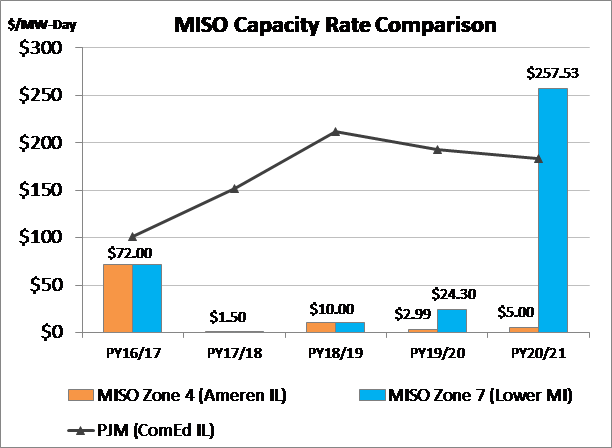Capacity: How Might It Impact My Forward Energy Supply Budget in Michigan?
3 min readCapacity is the component of electricity bills designed to ensure that there are enough generation resources to serve the energy grid on the hottest and coldest days of the year. As generation assets to meet these peak obligations cannot be built quickly, Midcontinent Independent System Operator (MISO) and the state of Michigan must plan several years in advance to meet these needs during high grid usage time periods.
This is all in part to meet the requirements of the Michigan Public Act 341, which was put in place to ensure there is enough capacity available to meet Michigan’s state-specific demands above and beyond the capacity set at the annual MISO auctions.
What happened at last year’s MISO auction?
At the yearly auctions held by MISO known as Planning Resource Auction (PRA), the available capacity for the planning year, beginning in June of that year, is revealed. Last year, Zone 7 (i.e., the Lower Peninsula of Michigan) cleared at $257.53/MW-day, a threshold called the Cost of New Entry (CONE), roughly 10 times the prior auctions’ clearing price. Cost of New Entry is used to indicate the current, annualized capital cost of constructing a power plant and is substantially higher to incentivize the building of new assets to meet a potential capacity shortfall.
For customers purchasing capacity at the market, they saw a dramatic increase in this pricing component versus previous years.
The chart below shows the annual Zone 7 (Lower Peninsula of Michigan) MISO auction rate for Capacity for the last several years, versus Zone 4 in Illinois:

Source: MISO, PJM
Why does my energy supplier reach out every year for a capacity commitment for 4 years from now?
Michigan’s Public Act 341 also requires alternative electric suppliers (AES) like Constellation who supply power to retail customers to demonstrate that they have sufficient capacity in place to meet their capacity obligation for a four-year rolling basis.
In February 2018, Constellation successfully filed to extend the four-year rolling capacity demonstration by an additional year. The current 4-year capacity time period required for suppliers is June 2021 – May 2025.
In February 2022, Constellation will file for the June 2025-May 2026 reporting period.
Can I avoid electricity budget surprises from the results of the annual MISO auction?
One of the ways customers can avoid substantial increases in their forward capacity rates is to fix capacity rates for future years. Constellation is able to offer fixed capacity by utilizing our wholesale team to procure the capacity rate from the bilateral market to meet a customers’ capacity requirement. Doing so allows customers to have budget certainty for their capacity rate.
What’s next for 2022?
As mentioned earlier, the next filing for capacity obligation will take place in mid-February 2022 for the June 2025-May 2026 reporting period. Later in 2021, several months in advance of the filing, Constellation will contact customers to provide information on the capacity market and will craft a strategy to their specific usage patterns for customer’s considerations to reduce the forward capacity budget risk.
We can assist customers by providing automated price tracking around capacity using our MarketWatch tool, which allows businesses to see what their rate for their specific facility would be on a weekly basis.
We will continue to keep both our customers and channel partners informed if there are any Michigan policy changes that could affect customers’ energy bills. If you’d like to stay informed about what’s happening in Michigan specific to your facility, please contact your Constellation representative for an update.

